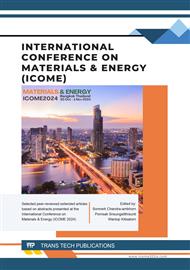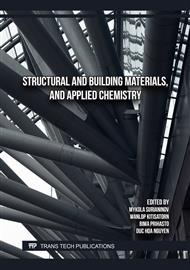[1]
T.M. Joseph, A. Kallingal, A.M. Suresh, et al., 3D printing of polylactic acid: recent advances and opportunities, Int J Adv Manuf Technol. 125 (2023) 1015–1035.
DOI: 10.1007/s00170-022-10795-y
Google Scholar
[2]
D. Jiang, F. Ning, Y. Wang, Additive manufacturing of biodegradable iron-based particle reinforced polylactic acid composite scaffolds for tissue engineering, Journal of Materials Processing Technology. 289 (2021).
DOI: 10.1016/j.jmatprotec.2020.116952
Google Scholar
[3]
F. Yang, J. Zeng, H. Long, J. Xiao, Y. Luo, J. Gu, W. Zhou, Y. Wei, X. Dong, Micrometer Copper-Zinc Alloy Particles-Reinforced Wood Plastic Composites with High Gloss and Antibacterial Properties for 3D Printing, Polymers 12 (2020) 621.
DOI: 10.3390/polym12030621
Google Scholar
[4]
J. Lee, H. Lee, K. Cheon, C. Park, T. Jang, H. Kim, H. Jung, Fabrication of poly(lactic acid)/Ti composite scaffolds with enhanced mechanical properties and biocompatibility via fused filament fabrication (FFF)–based 3D printing, Additive Manufacturing. 30 (2019) 100883.
DOI: 10.1016/j.addma.2019.100883
Google Scholar
[5]
K.K. Chawla, Composite Materials, Springer New York, New York, 1998, p.133–163.
Google Scholar
[6]
S. Chowdhury, A. Singh, B. Pal, Chapter 1 - Introduction to biomedical polymer and composites, Advances in Biomedical Polymers and Composites, Elsevier, 2023, pp.1-30.
DOI: 10.1016/b978-0-323-88524-9.00005-x
Google Scholar
[7]
H. Zhang, F. Ye, F. Chen, W. Yuan, W. Yan, Numerical investigation on the viscoelastic polymer flow in material extrusion additive manufacturing, Additive Manufacturing. 81 (2024).
DOI: 10.1016/j.addma.2024.103992
Google Scholar
[8]
M.P. Serdeczny, R. Comminal, Md.T. Mollah, D.B. Pedersen, J. Spangenberg, Numerical modeling of the polymer flow through the hot-end in filament-based material extrusion additive manufacturing, Additive Manufacturing. 36 (2020).
DOI: 10.1016/j.addma.2020.101454
Google Scholar
[9]
N. Sa'ude, K. Kamarudin, M. Ibrahim, M.H.I. Ibrahim, Melt Flow Index of Recycle ABS for Fused Deposition Modeling (FDM) Filament, Applied Mechanics and Materials. (2023) 773–774.
DOI: 10.4028/www.scientific.net/amm.773-774.3
Google Scholar
[10]
L. Sangroniz, M. Fernandez, A. Santamaria, Polymers and rheology: A tale of give and take, Polymer. 271 (2023).
DOI: 10.1016/j.polymer.2023.125811
Google Scholar
[11]
T. Budtova, P. Navard, Viscosity-temperature dependence and activation energy of cellulose solutions, Nordic Pulp & Paper Research Journal. 30 (2015) 99–104.
DOI: 10.3183/npprj-2015-30-01-p099-104
Google Scholar
[12]
J. Tungtrongpairoj, K. Doungkeaw, B. Thavornyutikarn, P. Suttipong, V. Uthaisangsuk, Processing and modeling of 3D-printed mill scale strengthened acrylonitrile butadiene styrene composites, Int. J. Adv. Manuf. Technol. 131 (2024) 1567–1586.
DOI: 10.1007/s00170-024-13037-5
Google Scholar
[13]
D. Tammaro, Rheological characterization of complex fluids through a table-top 3D printer, Rheol Acta. 61 (2022) 761–772.
DOI: 10.1007/s00397-022-01361-0
Google Scholar
[14]
A.A Rashid, M. Koç, Fused Filament Fabrication Process: A Review of Numerical Simulation Techniques, Polymers. 13 (2021) 3534.
DOI: 10.3390/polym13203534
Google Scholar
[15]
M.E.A. Papon, A. Haque, M.A.R. Sharif, Effect of Nozzle Geometry on Melt Flow Simulation and Structural Property of Thermoplastic Nanocomposites in Fused Deposition Modeling, J. Mater. Sci. Technol. (2023).
DOI: 10.12783/asc2017/15339
Google Scholar
[16]
N. Sa'ude, M. Ibrahim, M.H.I. Ibrahim, Melt Flow Behavior of Metal Filled in Polymer Matrix for Fused Deposition Modeling (FDM) Filament, J. Mater. Sci. Technol. (2023).
DOI: 10.4028/www.scientific.net/amm.660.84
Google Scholar
[17]
K. Doungkeaw, J. Tungtrongpairoj, Printability and Mechanical Properties of PLA/Iron Composites for FDM 3D Printing, In Key Engineering Materials. 978 (2023) 47–51.
DOI: 10.4028/p-yo4czk
Google Scholar
[18]
U. Eberhard, H.J. Seybold, Determination of the Effective Viscosity of Non-Newtonian Fluids Flowing Through Porous Media, Interdisciplinary Physics. 7 (2019).
DOI: 10.3389/fphy.2019.00071
Google Scholar



